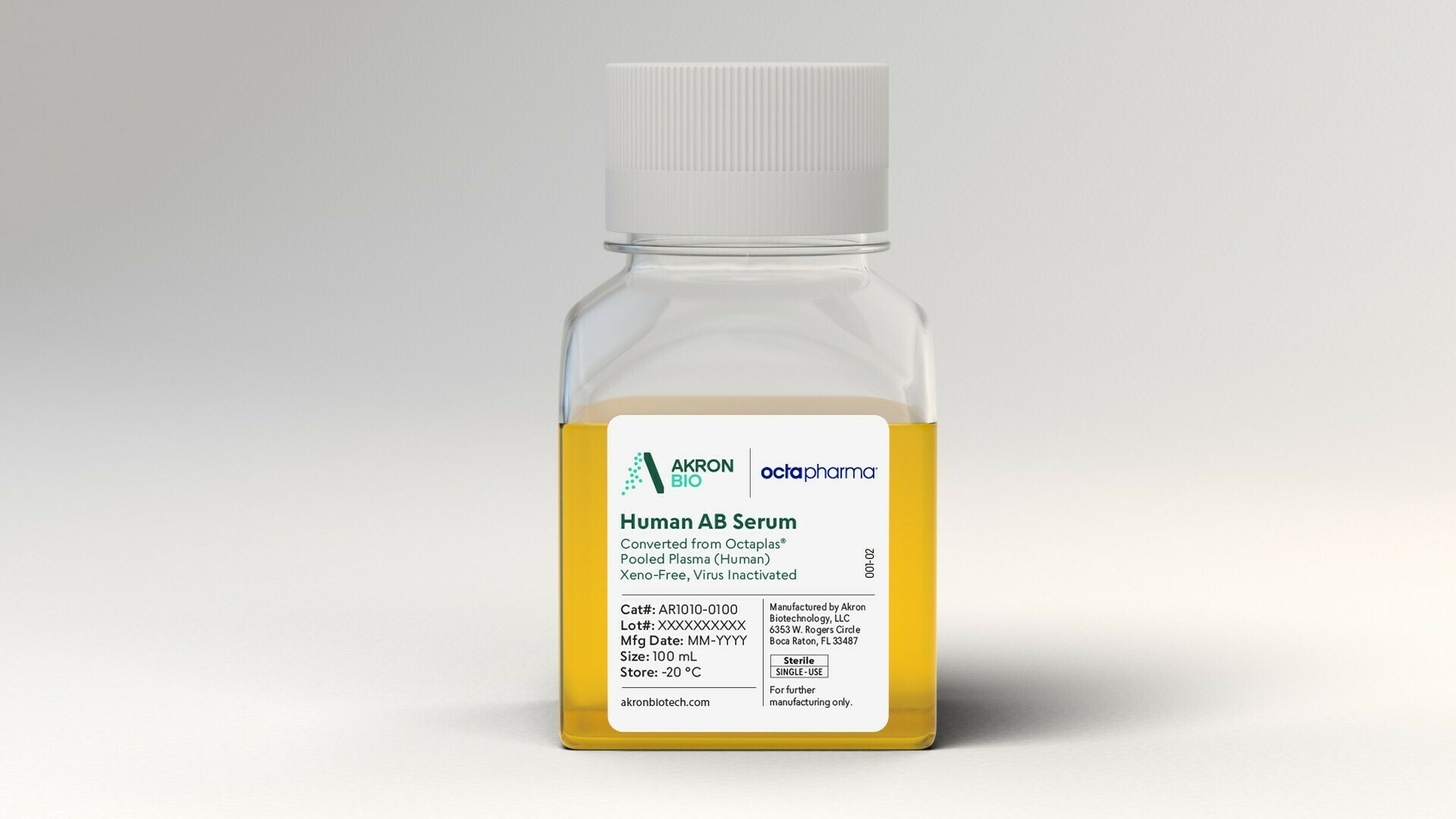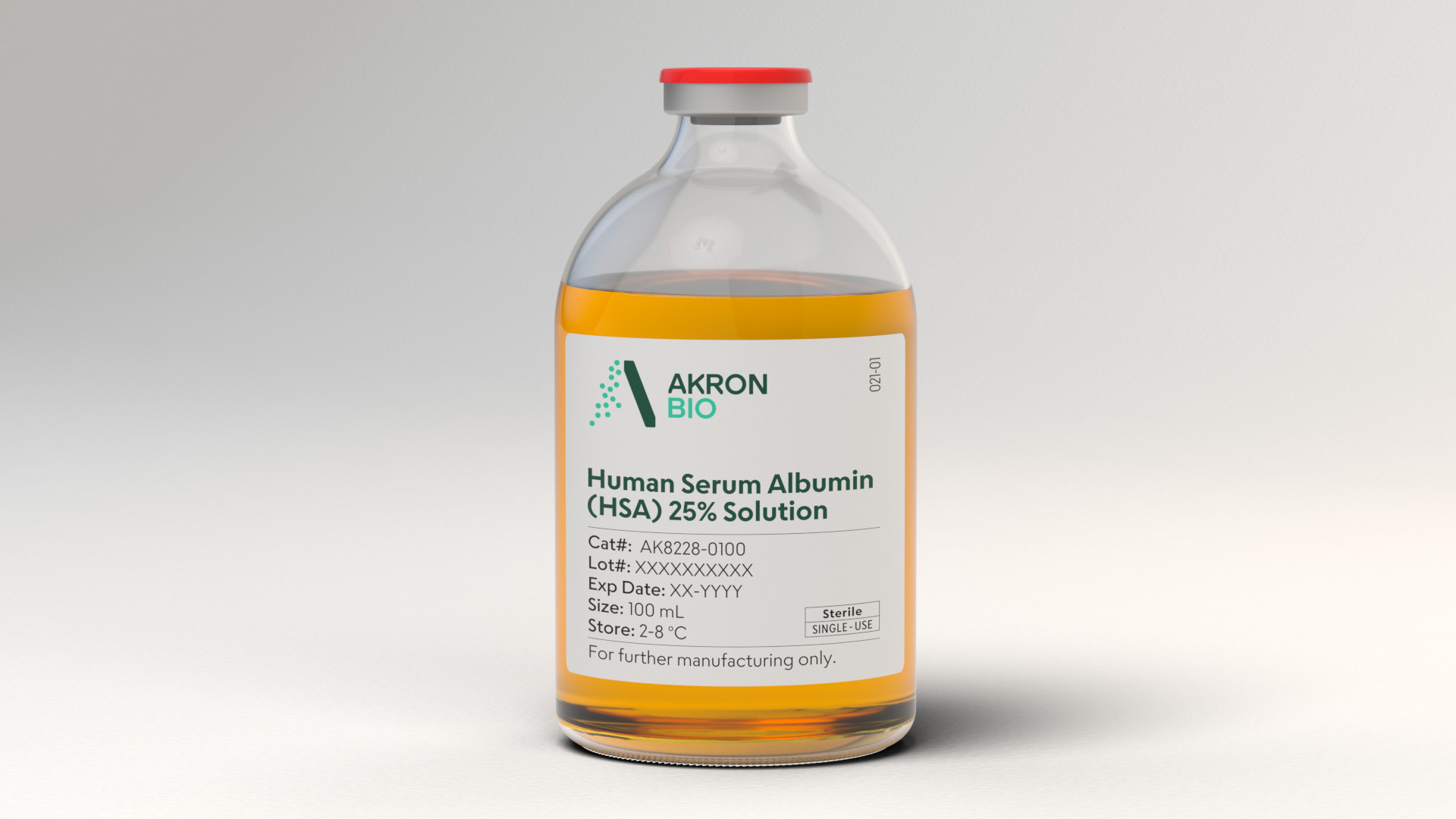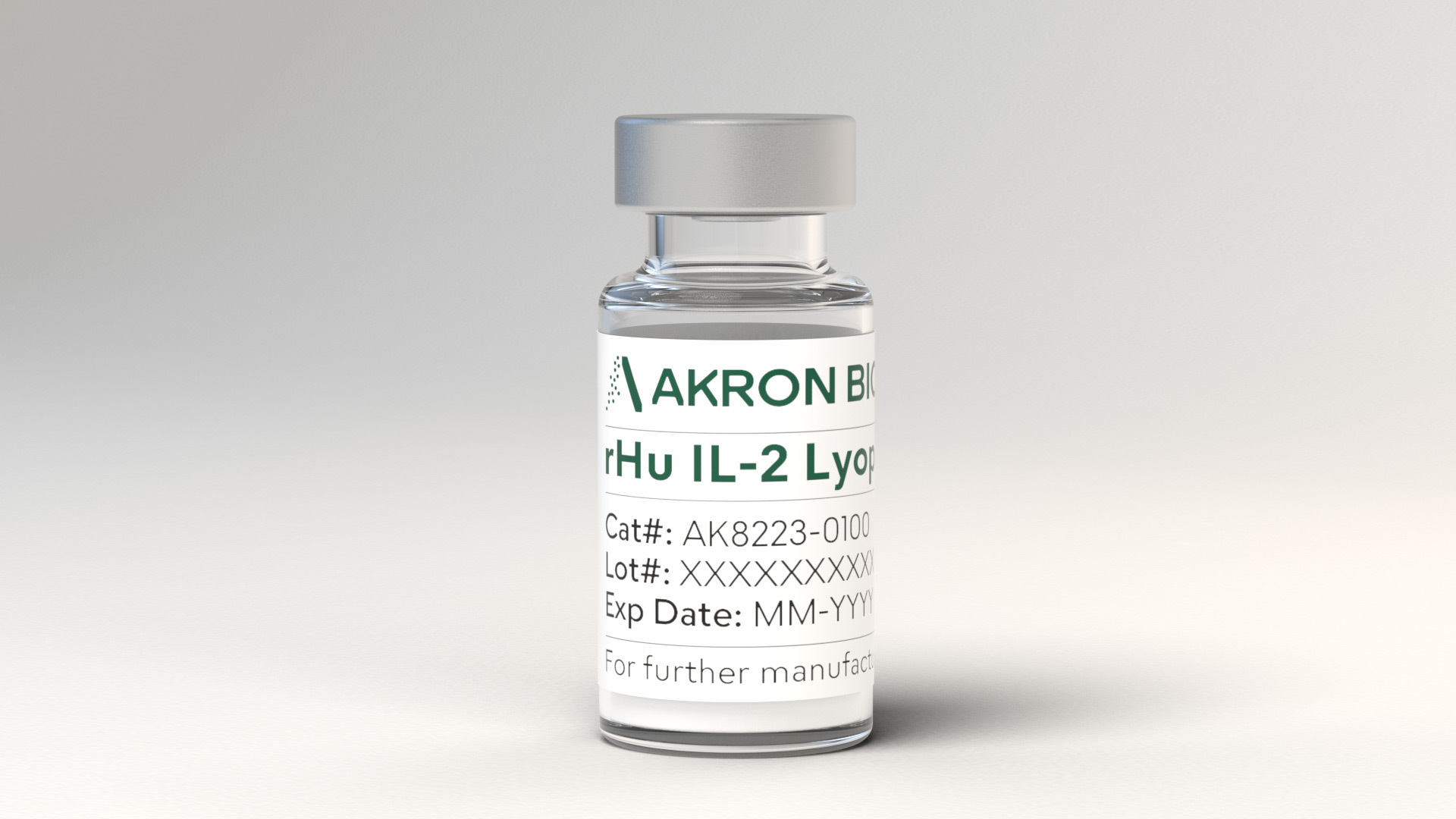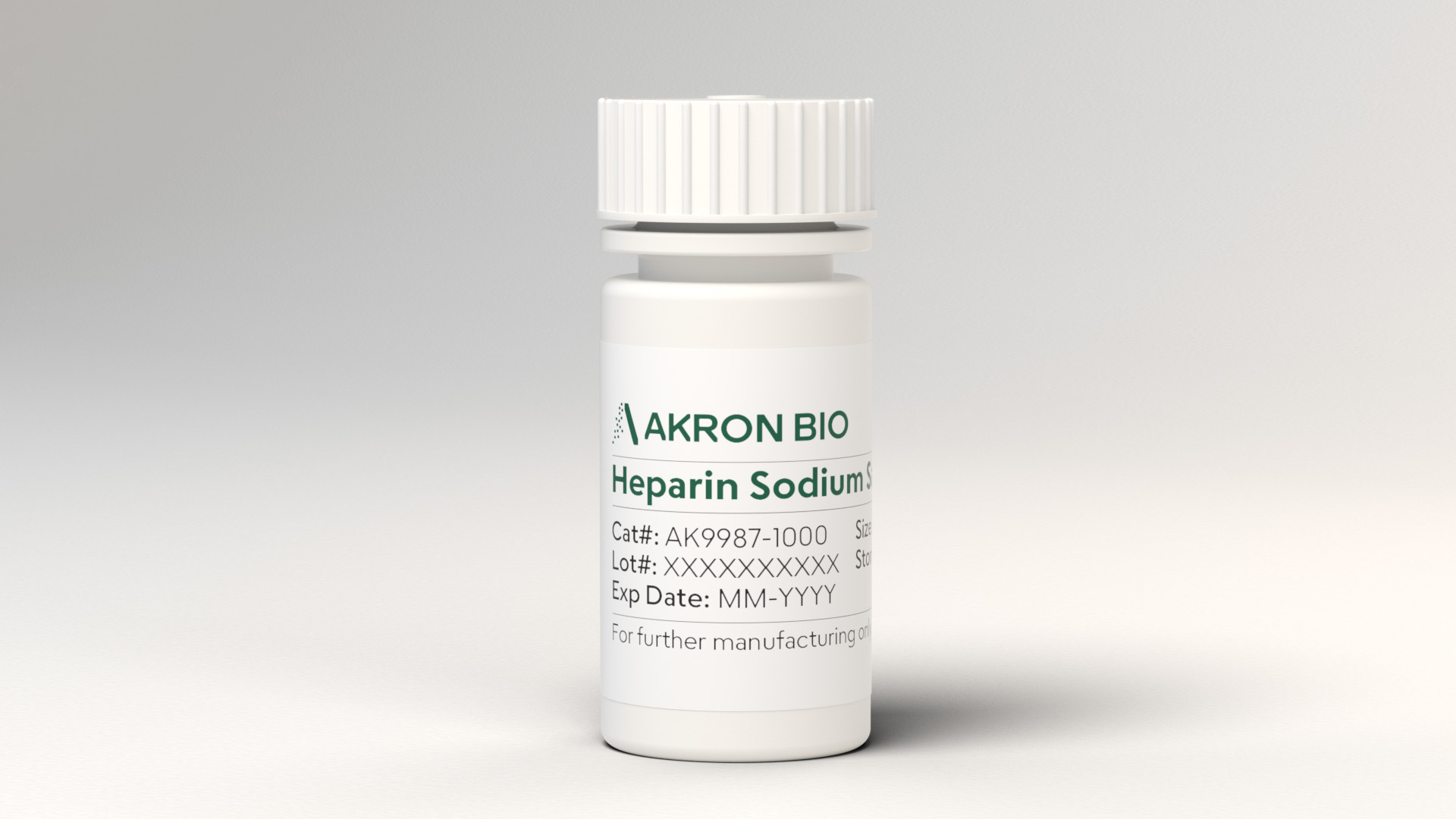
Human Fibronectin, Virus Inactivated, Research Grade
High quality research-grade materials.
Akron Bio’s Human Fibronectin Solution, Virus Inactivated is a high quality research-grade material designed to support development efforts in the cell therapy industry. This product leverages pharmaceutically licensed virus and prion inactivated plasma as a raw material, offering greater batch-to-batch consistency and a unique safety profile. Akron’s Human Fibronectin Solution, Virus Inactivated is purified from this raw material using a sterilized gelatin resin derived from a pharmaceutical-grade polygeline solution.
For cGMP Human Fibronectin, click here.
Donor Eligibility
• Pharmaceutically licensed, pooled plasma from US-licensed plasma donation centers
• Donor screening and virus testing per 21 CFR 610.40
• Nucleic Acid Testing (NAT) conducted for HIV, B19V, HAV, HBV, HCV, & HEV
Raw Material
• Solvent Detergent (S/D) treatment for virus inactivation of enveloped viruses
• Immune Neutralization for inactivation of certain non-enveloped viruses
• Affinity Chromatography to reduce prion proteins
• Sterile microfiltration to minimize the presence of bacteria and parasites
Stability
• Currently on a long-term stability program
• Store at -20 °C
• Transport on dry ice
• Avoid repeated freeze-thaw cycles
For Use Statement
For research use only. Not for human use. This product is not intended for direct in vivo use or for direct clinical use as a drug, therapeutic, biologic, or medical device.
• Appearance
• pH
• Purity (Reducing SDS-PAGE)
• Identity (Reducing SDS-PAGE)
• Protein Concentration
• Mycoplasma
• Bacterial Endotoxins
1. Why use Human Fibronectin Solution, Virus Inactivated?
Human Fibronectin Solution, Virus Inactivated is used as a media supplement in cell culture primarily to facilitate attachment and cytoplasmic spreading during cell and tissue culture for all types of anchorage dependent cells. Akron leverages pharmaceutically licensed virus and prion inactivated plasma as the raw material, offering greater batch-to-batch consistency and a unique safety profile.
2. What are the recommended storage conditions for Human Fibronectin Solution, Virus Inactivated?
We recommend storing this product at -20 °C upon receipt. Avoid repeated freeze-thaw cycles.
3. What are the shipping conditions for Human Fibronectin Solution, Virus Inactivated?
This product ships with dry ice.
4. What is the shelf-life for Human Fibronectin Solution, Virus Inactivated?
This product is currently under a long-term stability program.
5. What is the thawing procedure for Human Fibronectin Solution, Virus Inactivated?
We recommend thawing this product at 2-8 °C for 8-12 hours. This protein is sensitive to perturbations; do not vortex or handle roughly. Do not repeatedly pipette to resuspend the fibronectin as this may cause the protein to irreversibly precipitate out of solution. See Methods of Use for further instructions.
6. Where is the raw material sourced?
Only plasma from US donors is used (frozen within 8 hours of collection). Individual donor identification, registration, and education takes place in FDA-licensed centers which comply to the requirements for the collection of source materials as specified in “The Collection, Fractionation, Quality Control, and uses of Blood and Blood Products,“ published by the WHO Technical Report Series 840. This allows for traceability down to the single donation unit, if needed.
7. How are the plasma donations screened?
There is a deferral check and questionnaire at each donation, as well as a physical assessment, per 21 CFR 630.10. Each plasma unit used as raw material is virus tested per 21 CFR 610.40 at the time of collection and found negative or non-reactive for Hepatitis B surface Antigen (HBsAg), antibodies to Human Immunodeficiency Virus (HIV)-1/2 (anti-HIV-1/2) and antibodies to Hepatitis C Virus (anti-HCV). HBV and HIV-1/2 serological tests are also performed on each plasma pool. Nucleic Acid Testing (NAT) is also performed at different manufacturing stages for HIV-1, HIV-2, B19V, HAV, HBV, HCV and HEV.
8. Does this product have a TSE/BSE statement?
Yes, a TSE/BSE statement is available upon request for this product.
9. What process is used for viral inactivation?
Viral inactivation is accomplished via solvent detergent (S/D) treatment and immune neutralization (see Technical Overview).
10. What are the advantages of S/D treatment versus other inactivation methods currently used?
S/D treatment has long been a standard and robust viral inactivation process for plasma products. S/D is extremely effective against enveloped viruses, reduces abnormal prion proteins, has mild effect on the overall protein quality and leaves most labile coagulation factors intact. pH inactivation will irreversibly denature and destroy many viruses, but it might compromise the beneficial qualities of the material. Heat inactivation, irradiation, chromatography, and filtration methods have all been shown to have inactive effect on both non-enveloped and enveloped viruses. Overall, the virus inactivation of plasma products should be validated by antibody and PCR methods to detect a panel of regulatory agent defined adventitious viruses. The pathogen safety studies should be incorporated for all relevant steps of the manufacturing process. A combination of these methods is used to reduce the overall risk of adventitious viruses and bloodborne pathogens in plasma products.
11. Are non-enveloped viruses inactivated also?
S/D treatment is not effective against non-enveloped viruses. However, the presence of standardized levels of neutralizing antibodies in the plasma pool along with virus load control by redundant NAT screening minimizes the risk of transmitting non-enveloped viruses such as HAV and parvovirus B19V.
12. Is there S/D agent remaining in the product that might affect cell growth?
Remaining levels of S/D agents are below what has been found to impair cell growth.
13. What safety testing is done on the final product?
Every lot of final product is tested for the presence of Mycoplasma and Bacterial Endotoxins.
14. Which cell types are suitable?
Human Fibronectin Solution, Virus Inactivated will facilitate attachment and cytoplasmic spreading during cell and tissue culture for all types of anchorage-dependent cells. Fibronectin has been shown to promote cell adhesion, spreading, proliferation, and differentiation for a variety of cultured cell types.
15. Is the performance comparable to competitor products?
To our knowledge, no other virus inactivated human fibronectin product currently exists on the market. Functionality data for this product is available upon request.
16. Do you have an SDS for this product?
Yes, an SDS is available upon request.
17. Is this an injectable-grade or clinical-grade material?
No, this product is not for direct use in humans. See intended use below.
18. What is the intended use for the product?
For research use only. Not for human use.
19. What is the molecular weight of Akron’s Human Fibronectin, Virus Inactivated, Research Grade?
Each lot meets molecular weight specifications based on SDS-PAGE analysis with resulting band appearing between 220-250 kDa.
20. What packaging options are available?
Akron’s Human Fibronectin, Virus Inactivated, Research Grade product is available in two different standard aliquot sizes: 1 mg and 5 mg. Both package materials are sterile, RNase and DNase free, USP Class VI material, which were produced in a controlled environment in compliance with ISO 13485:2016. Our 1 mg aliquot is packaged in a 1.5 mL free standing microcentrifuge tube made from clear polypropylene closed with a matching screw cap including an ethylene propylene O-ring. These tubes are endotoxin-free, manufactured in an ISO 8 cleanroom environment in compliance with ISO 9001:2015, and meet the requirements of the Restriction of Hazardous Substances Directive 2002/95/EC. Our 5 mg aliquot is packaged in an 8 mL diagnostic bottle made from high density polyethylene with a white linerless polypropylene screw cap. These bottles are hDNA and pyrogen free. Custom packaging options are available with different materials or volumes for contract orders.
Fibronectin is an important blood plasma and extracellular matrix (ECM) protein that facilitates attachment and cytoplasmic spreading during cell and tissue culture for all types of anchorage-dependent cells. Fibronectin has been shown to promote cell adhesion, spreading, proliferation, and differentiation for a variety of cell types and is considered a serum-free media supplement. In vivo, fibronectin is also responsible for cell adhesion and migration processes including embryogenesis, wound healing, blood coagulation, host defense, and metastasis.
Aliquot Sizes & Formats
Liquid Tubes (1 mg) Cat. # AR1049-0001
Liquid Bottles (5 mg) Cat. # AR1049-0005
Protein Concentration (1 mg/mL)
cGMP Fibronectin - Cat. # AK9930






